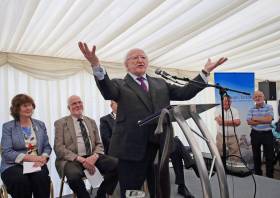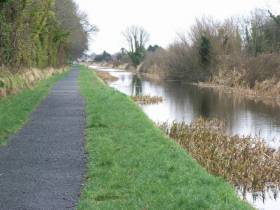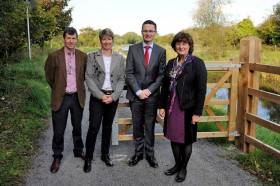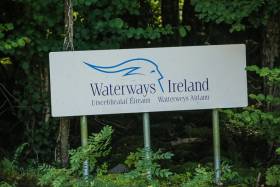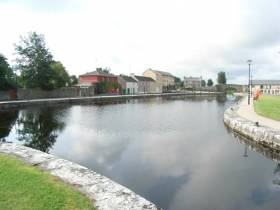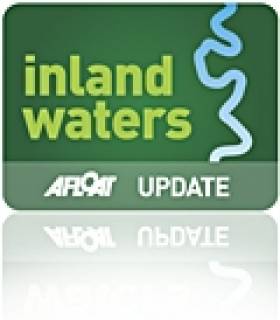Displaying items by tag: Royal Canal
The President of Ireland, Michael D. Higgins, commemorated the Royal Canal's 200th Anniversary in the presence of Waterways Ireland, the Royal Canal Amenity Group and invited guests in Clondra, Co Longford on the 27th May 2017. The President unveiled a plaque before speaking at the event in the presence of 300 guests.
The event took place on the anniversary of the day when the canal was completed all the way to the Shannon in 1817. During its heyday, people, coal and crops were moved to Dublin from Arigna Mines, farms and rural communities all over the North West, and people and goods returned. The Royal Canal closed in 1960 and remained closed for 50 years. The Canal reopened to navigation in 2010 following extensive lobbying and volunteer work by the Royal Canal Amenity Group and the work of Waterways Ireland staff. In its 25th year of operation the Royal Canal also saw the mass exodus of people escaping the famine by walking the towpath to Dublin to take a boat to the new world. The largest known group of 1490 people left the Mahon Estate at Strokestown House to walk to Dublin, along the Royal Canal, 175 years ago this week. They were also commemorated as part of the ceremony with President Higgins review of the bronze shoes and plaque on the plinth in Richmond Harbour. The shoes are similar to those given to the 1490 people for their journey to Canada.
As Minister for Arts, Heritage, Gaeltacht and the Islands, in the 1990's President Higgins had responsibility for the inland waterways in the portfolio. The President drove the re-vitalisation of the canal networks, including the redevelopment of the Royal Canal, through his efforts and funding for works on the canal.
Speaking about the role of the volunteers in the restoration, Matt Kennedy Chairperson of the Royal Canal Amenity Group said "this 145km Linear-parkway owes its existence to the perseverance and hard work by volunteers from the Royal Canal Amenity Group and staff from what is now Waterways Ireland. And as the Royal Canal moves into its next 100 years we look forward to working with Waterways Ireland and indeed all those who are committed to further developing and promoting this wonderful amenity as it moves to link up with walking and cycling routes across Europe"
Dawn Livingstone, Chief Executive, Waterways Ireland spoke saying "President Higgins spoke so eloquently about the Royal Canal and its place in our heritage. The Royal Canal is a wonderful recreational amenity free for all to use. Our partnerships with the local authorities, the boating groups including the Royal Canal Amenity Group, Fáilte Ireland and organisations such as the Irish Heritage Trust, are working to deliver new and exciting visitor experiences along the Royal Canal as such as the Blueway and the National Famine Way. These developments will deliver step change for tourism and the local economy in these areas."
James Osborne, Chairman of the Irish Heritage Trust said: "As the famine walkers set off today, they will not only be walking in the footsteps of the 1,490 Strokestown emigrants, but also helping to blaze a trail for the National Famine Way. It is only fitting that we mark this occasion with the unveiling of a nineteenth-century pair of shoes cast in bronze that is inscribed: “in Memory of the largest known group to have walked the full length of the Royal Canal – the 1,490 Strokestown Famine Emigrants in May of 1847”.
The President of Ireland, Michael D. Higgins, will commemorate the Royal Canal's 200th Anniversary in the presence of Waterways Ireland, the Royal Canal Amenity Group and invited guests in Clondra, Co Longford on the 27th May 2017. The event takes place on the anniversary of the day when the canal was completed all the way to the Shannon in 1817.
The Royal Canal closed in 1950 and remained closed for 50 years. The extensive lobbying and volunteer work of the Royal Canal Amenity Group and the work of Waterways Ireland staff and their predecessors in OPW was rewarded in 2010 when the Canal was reopened to navigation.
President Higgins has been a significant supporter of the Royal Canal and the inland waterways for many years. As Minister for Arts, Heritage, Gaeltacht and the Islands, the President drove the re-vitalisation of the canal networks, including the redevelopment of the Royal Canal.
Now a vibrant recreational location, investment by Waterways Ireland and Longford County Council in conjunction with Fáilte Ireland has revitalised Richmond Harbour, Clondra, now a Blueway hub. Additional investment by local authority partners along the length of the Royal Canal has seen the upgrade of the towpath to international trails standard. Only a short section in Co Longford remains to be upgraded before the entire 144km towpath can be promoted internationally.
Dawn Livingstone Waterways Ireland Chief Executive spoke saying "I am delighted that the Royal Canal Commemorations will be honoured by the presence of President Higgins. The volunteers and staff worked so hard to reopen this navigation. They have provided a valuable service to the people of Ireland by their fight to keep this wonderful recreational amenity in public hands. As a result it is here providing opportunities for every community to freely use for work, visit, play and thrive"
Should people wish to attend the commemorations on the 27th May, they are welcome to come to the harbour. The village will be closed to traffic from early on the day and so invited guests should park in Tarmonbarry where a small coach will bring them to and from the harbour.
Attendees can expect to see the unveiling of commemorative plaques, traditional crafts and special arrivals by boat and horse & cart. Following the speeches, walkers from Irish Famine Trust at Strokestown House will set off to walk to Dublin in the steps of the 1490 people who left the Mahon Estate to walk to Dublin and the boat to America 175 years ago this week. Music will be provided by the Garda Band who will perform on the quayside.
Royal Canal Bicentenary Celebration This Summer
#RoyalCanal - Dun Laoghaire Harbour isn’t the only aquatic attraction in Ireland celebrating a bicentenary this year, as the Royal Canal’s 200th anniversary also takes place this summer.
Waterways Ireland, in association with the Royal Canal Amenity Group, will shortly announce an events programme marking two centuries since the opening of the inland waterway to the Shannon, with festivities set to begin from 27 May.
Royal Canal Towpath Closure In Maynooth Extended Till March
#RoyalCanal - Waterways Ireland advises that the Royal Canal towpath west of Maynooth, Co Kildare from Bond Bridge to Jacksons Bridge, a section of around 1.7km in length, will remain closed until March to undertake further cycle and pedestrian upgrade works along the waterway.
The works form part of the Royal Canal Greenway, which saw an extension in Westmeath from Coolnahay Harbour to the Longford county border opened last October, as previously reported on Afloat.ie.
New Royal Canal Greenway Section Opened In Westmeath
#InlandWaters - The extension of the Royal Canal Greenway in Westmeath from Coolnahay Harbour to the Longford county boundary was officially opened last week.
The new greenway, a 14.4km cycle way, links with the 32.6km already provided along the waterway under an earlier scheme.
Minister of State for Tourism and Sport Patrick O'Donovan joined Cllr Frank McDermott, Cathaoirleach of Westmeath County Council and Waterways Ireland chief executive Dawn Livingstone to officially opened this phase of the cycle way on Friday 7 October.
The aim of the project is to increase the number of walkers and cyclers to the Royal Canal, whether commuting along the Greenway or for recreational purposes.
The project, made possible with funding granted in 2013 and a licence from Waterways Ireland, involved upgrading works and surface dressing on certain sections of the Royal Canal along with informative signage, seating and cycle-friendly gates.
The new cycle path is already in use by both pedestrians and cyclists and is reportedly proving a popular recreational facility in the area.
Canal Passages Into & Out of Dublin Suspended Due to Anti–Social Behaviour
Waterways Ireland is advising masters and owners of vessels that passages into and out of Dublin are presently suspended in light of recent anti-social behaviour which has given rise to safety concerns for boaters and staff alike.
Inspector of Navigation C.J.Lawn says the 'present arrangements are being reviewed' to ensure that there is adequate security to ensure safety for all concerned in order that passages can be resumed at the earliest opportunity.
Clondra Hosts Canoeing Club Championships Next Month
#Canoeing - Richmond Harbour on the Royal Canal in Clondra, Co Longford will be the site of the Canoeing Ireland Club Championships over the weekend of 16-17 April.
As the Longford Leader reports, the event coincides with the second annual Longford Blueway Festival taking place in the town and surrounds.
Up to 500 competitors and their supporters are expected in Clondra for the national canoeing contest which joins a number of events scheduled for the weekend, including cycles and walks of the 10km Camlin Loop of the Shannon Blueway that was launched last year, as previously reported on Afloat.ie.
There will also be public 'taster sessions' on the water for those curious about canoeing whether for sport or recreation. Details are available on the Canoeing Ireland website.
The Longford Leader has more on the story HERE.
Gardai Restrict Boat Movement on the Grand & Royal Canals
Waterways Ireland has been requested by An Garda to limit boat movements on the Royal and Grand Canals in the Kildare area throughout this week from 25 to 31 January, during the course of an on-going investigation, particularly from the Dublin county boundary to Sallins and Maynooth respectively on the two canals.
Waterways Ireland asks that owners and masters abide by this request, and plan boat movements accordingly.
#royalcanal – Spencer Dock Sea Lock at the Royal Canal in Dublin has been closed til further notice due to unforeseen repair requirements at one of the lock gates.
Upcoming Newcomen Bridge Lifts are also cancelled until these works can be carried out.
Waterways Ireland has apologised to customers for inconvenience caused and say they will issue an update notice when further information is available.
Royal Canal: Newcomen Bridge Lift Dates For 2015
#InlandWaters - The schedule of lift dates 2015 for Newcomen Bridge on the Royal Canal in Dublin city centre runs from the end of April till the end of September.
Arrangements have been made for Irish Rail to open the bridge on the following dates and times, if there is demand:
Monday 27 April 11am–1pm
Sunday 3 May 9am–1pm
Saturday 30 May 9am–1pm
Thursday 11 June 11am–1pm
Thursday 9 July 11am–1pm
Thursday 23 July 11am–1pm
Monday 24 August 11am–1pm
Monday 21 September 11am–1pm
The Waterways Ireland Eastern Regional Office requires two weeks' notice from boaters for use of these lifts.
Should there not be demand (a minimum of two boats for passage) for a particular date, Irish Rail will be notified by Waterways Ireland that this lift is cancelled.
A maximum number of boats passing will be implemented to keep to the times given above for the planned lifts (16 for weekend lifts, eight for weekday lifts).
On day of lift, boaters and passengers must follow guidance from Waterways Ireland staff about sequence of passage under the bridge and through Lock 1, and must remain within signed and designated areas.
To give notice of any intended passage of Newcomen Bridge, contact the Eastern Regional Office at 01 868 0148 or [email protected]


























